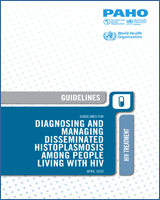Histoplasmosis is a disease caused by the fungus Histoplasma capsulatum. This disease is highly endemic in some regions of North America, Central America, and South America and is also reported in certain countries of Asia and Africa. It often affects people with impaired immunity, including people living with HIV, among whom the most frequent clinical presentation is disseminated histoplasmosis. The symptoms of disseminated histoplasmosis are non-specific and may be indistinguishable from those of other infectious diseases, especially disseminated tuberculosis (TB), thus complicating diagnosis and treatment. Histoplasmosis is one of the most frequent opportunistic infections caused by fungal pathogens among people living with HIV in the Americas and may be responsible for 5–15% of AIDS-related deaths every year in this Region.
These guidelines aim to provide recommendations for the diagnosis, treatment, and management of disseminated histoplasmosis in persons living with HIV. Although the burden of disease is concentrated in the Americas, the recommendations contained within these guidelines are applicable globally. These guidelines were produced in accordance with the World Health Organization (WHO) handbook for guideline development. The Guideline Development Group elaborated the final recommendations based on systematic review of scientific literature and critical evaluation of the evidence available using the Grading of Recommendations, Assessment, Development, and Evaluation (GRADE) approach.
These guidelines are intended for health-care providers, HIV program managers, policy-makers, national treatment advisory boards, and other professionals involved in caring for people who either have or may be at risk of developing disseminated histoplasmosis.
Recommendations
Diagnosis of disseminated histoplasmosis among people living with HIV: Among people living with HIV, disseminated histoplasmosis should be diagnosed by detecting circulating Histoplasma antigens (conditional recommendation; low-certainty evidence).
Induction and maintenance of antifungal treatment regimens for disseminated histoplasmosis among people living with HIV
Disseminated histoplasmosis classification definitions
Severe or moderately severe histoplasmosis is defined as the presence of at least one sign or symptom involving vital organs: respiratory or circulatory failure, neurological signs, renal failure, coagulation anomalies and a general alteration of the WHO performance status greater than 2, in which the person is confined to a bed or chair more than half of the waking hours and only capable of limited self-care.
Mild to moderate histoplasmosis is defined as signs and symptoms that do not include the above features defining severe or moderately severe histoplasmosis.
- 2.1.
Induction therapy
- 2.1.1.
Treating severe or moderately severe histoplasmosis among people living with HIV: liposomal amphotericin B, 3.0 mg/kg, for two weeks is recommended (conditional recommendation; very-low-certainty evidence).
In settings where liposomal amphotericin B is unavailable, deoxycholate amphotericin B, 0.7–1.0 mg/kg, is recommended for two weeks (conditional recommendation; very-low-certainty evidence). As a good practice for people with renal failure, or at risk of renal injury, measures to prevent or treat toxicity are recommended (subsection 3.5).
Induction therapy should be given for two weeks. Since deoxycholate amphotericin B may be associated with renal toxicity, therapy may need to be shorter than two weeks based on the clinical assessment of how the person responds to treatment. Involvement of the central nervous system may require extending induction therapy or increasing dosage.
- 2.1.2.
Treating mild to moderate histoplasmosis among people living with HIV: itraconazole 200 mg three times daily for three days and then 200 mg twice daily is recommended (conditional recommendation, very-low-certainty evidence).
- 2.2.
Maintenance therapy: itraconazole 200 mg twice daily for 12 months is recommended (conditional recommendation; very-low-certainty evidence). Less than 12 months of therapy can be considered when the person is clinically stable, receiving antiretroviral therapy, has suppressed viral load, and the immune status has improved (conditional recommendation, very-low-certainty evidence).
Timing of antiretroviral therapy initiation: antiretroviral therapy should be initiated as soon as possible among people with disseminated histoplasmosis for whom central nervous system involvement is not suspected or proven (conditional recommendation; very-low-certainty evidence).
TB therapy for people coinfected with TB, HIV, and histoplasmosis: People living with HIV with TB and histoplasmosis coinfection should receive TB therapy according to WHO treatment guidelines (conditional recommendation; very-low-certainty evidence)

